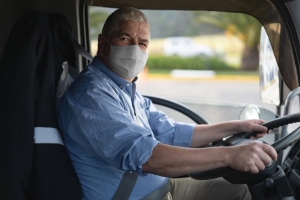
Long-haul truckers spend extended periods of time in their trucks, and they reach stops and destinations that place them at exposed risk to COVID-19. From dock to rest area workers, a long-haul trucker can come into contact with many people — one of whom could be a carrier of the virus that has infected over 5 million people to date.
Fortunately, the Centers for Disease Control and Prevention (CDC) recently released helpful guidance for communities, schools, and workplaces. With regard to workplaces, the CDC has compiled detailed health and safety steps those in specific occupations can take to best protect themselves and those around them.
The CDC’s team of professional researchers and health experts has created guidance for long-haul truckers, and we’re highlighting the top points to keep in mind.
#1: If you are sick, follow these steps
These steps are intended to prevent the spread of COVID-19:
- Stay home, except to get necessary medical care. Avoid public transportation if you need to see a medical professional, and be sure to call ahead.
- Separate yourself from people as much as possible. If possible, stay in a specific room in your home if you’re living with other people.
- Monitor your symptoms, such as fever, cough, and shortness of breath, and follow instructions from your healthcare provider and local health department. Your local health department may be able to give you instructions on checking your symptoms and reporting information.
#2: Maintain at least 6 feet of distance from others
We know you’ve heard this tip many times by now, but that’s because it’s so important. While on the road, you can take the following precautions to limit contact with others:
- Pack food, water, and essential supplies to limit convenience stops.
- Contact facilities in advance to make an appointment for unloading cargo.
- Use a radio or phone to talk with dock managers and other drivers if possible.
- Keep your truck well-ventilated.
- Use paperless, electronic invoicing for fueling, deliveries, and other tasks.
#3: Wear that face covering
Covering your nose and mouth with a face covering goes a long way nowadays in preventing the spread of the virus, and it is especially imperative when you’re in a setting where social distancing measures are difficult to maintain. The reason being is that masks protect vulnerable people from catching COVID-19 by preventing the virus from spreading from possibly-symptomatic carriers. It is estimated that anywhere from 6% to 18% of those infected can carry the virus without developing symptoms, so masks are especially critical.
It’s also imperative to keep in mind that wearing face coverings is more effective the more people participate. Two people interacting with face coverings are much safer than one person with it on and one with it off.
#4: Use your most powerful weapon — your disinfectant
The CDC recommends that truckers regularly clean and disinfect frequently touched surfaces in their truck, such as the sleeper berth, door handle, windshield wipers, light switch, and arm and headrests.
You should also make sure you’re using the right disinfectants, which are these products that meet the Environmental Protection Agency’s criteria for use against SARS-CoV-2.
#5: Protect your hands
This is another tip that will be drilled into the inner recesses of our minds for the rest of our lives, but it’s always been important — and especially so now. Soap, water, and your favorite tunes for at least 20 seconds — we know by now you know the drill.
Here are the key times you should wash your hands if you’re a trucker:
- Before eating or preparing food
- Before entering and leaving the cab
- After putting on, touching, or removing your face covering
- After blowing your nose, coughing, or sneezing
- After using the restroom
#6: Ensure your cab is equipped with tissues and a trash can
This sounds pretty self-explanatory, but truckers should also be strategic here. Keeping your tissues out of reach or your trash can at the back of the cab means that you’re spreading more unnecessary germs than needed. We recommend keeping a trash can and tissue box by your sleeper berth and at the front of the cab to cover your bases.
#7: Truckers are not the only ones responsible for their safety — employers share the responsibility
The CDC recommends that employers should have a COVID-19 response plan to protect drivers and back-office staff alike. To secure the health and safety of their employees, employers should do the following:
- Provide truckers with PPE, including vests, safety glasses, and hard hats, so they don’t need to borrow these items from shippers.
- Equip all cabs with alcohol-based sanitizers that contain at least 60% alcohol.
- If a cab absolutely must have two drivers in a cab, install a removable barrier between the driver and passenger. This should not only be reserved for the cab. You should institute physical distancing measures in your back office as well.
Visit this page for a full look at the CDC’s recommendations for long-haul truckers and employers. While this blog post is the most relevant to long-haul trucking, you can read our blog post from this March for more general tips on how to stay smart, safe, and sanitary amid COVID-19.